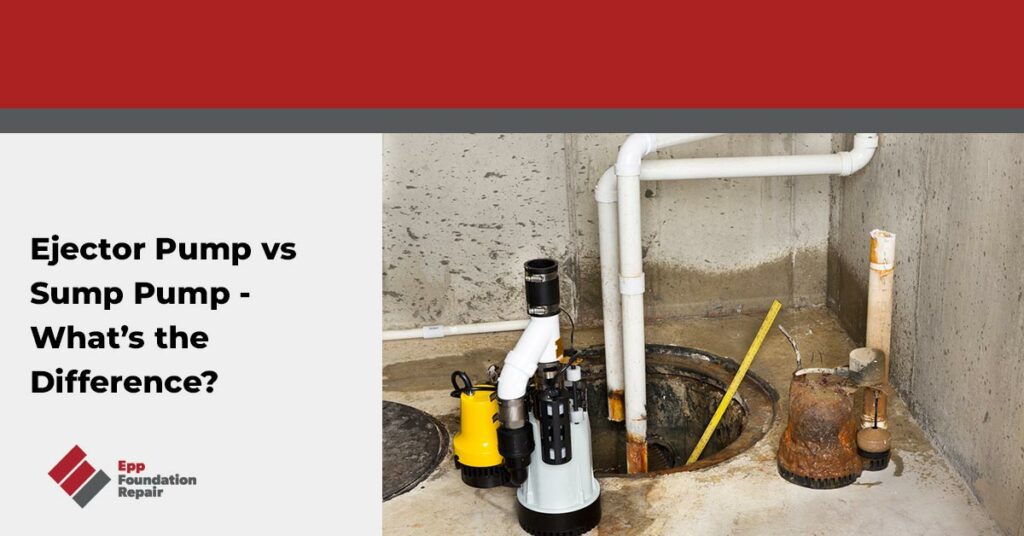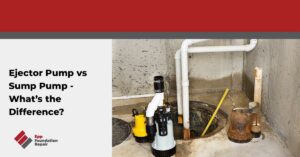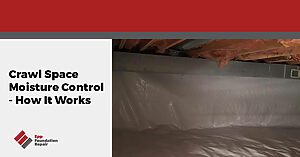Wondering what’s the difference between an ejector pump vs. a sump pump? If so, you’ve landed on the right page because that’s what we’re going to review in this article. We’ll review the difference between ejector pumps and sump pumps, how they work, help you determine which one you need, and more.
What’s the Difference Between a Sump Pump and an Ejector Pump
What is a Sump Pump?
A sump pump is a device installed in a home’s basement or crawlspace to prevent flooding and water damage. Sump pumps are typically powered by electricity but can also be battery-operated for use during power outages. Sump pumps come in various sizes and capacities, depending on the size of the area they’re intended to protect and the expected level of water flow. They can be installed in various configurations, such as a standalone unit or a larger system with multiple pumps and backup power sources. Some models have additional features, such as alarms or sensors that alert homeowners to potential issues.
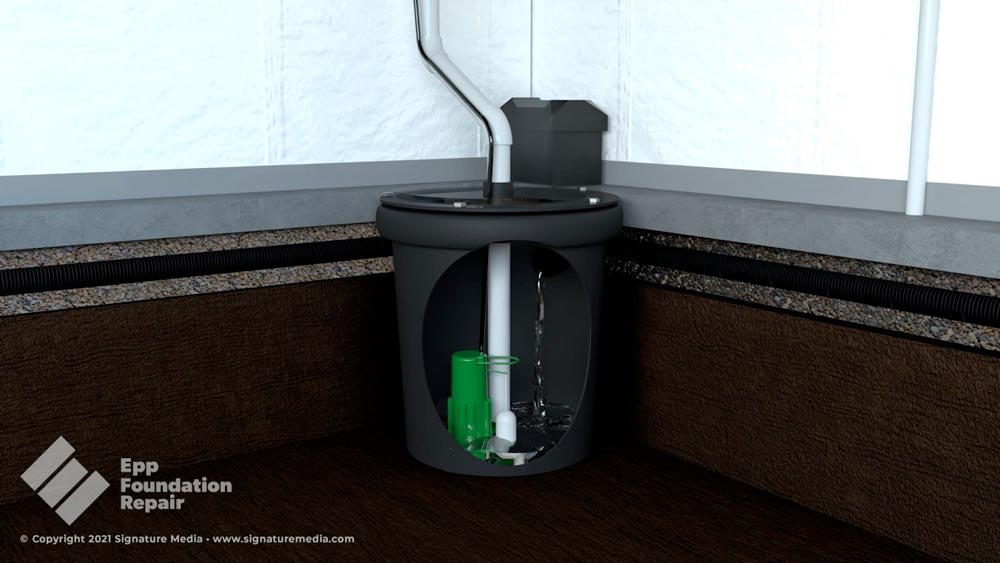
There are two types of sump pumps: pedestal and submersible. Pedestal sump pumps consist of a motor that sits above the sump basin and a long metal tube extending into the basin to pump out water. In contrast, submersible sump pumps are entirely submerged in the sump basin and push water out through a discharge pipe. Submersible pumps tend to be more efficient and quieter than pedestal pumps.
In addition to preventing flooding and water damage, sump pumps can also help to reduce the risk of mold growth and other moisture-related issues that can impact indoor air quality and overall health. Many homeowners and building owners install sump pumps as a preventative measure, particularly in areas prone to heavy rainfall or flooding.
For more information, see The Importance Of Proper Foundation Drainage Around Your Home.
What is an Ejector Pump?
An ejector pump, also known as a sewage ejector pump, is designed to transport sewage or wastewater from a building’s lower plumbing system up to a septic or sewer system. This type of pump is essential when the building’s plumbing fixtures are located below the main sewage line or septic tank level. Ejector pumps utilize the Venturi principle, which involves using a nozzle that converts the water flow into a high-pressure stream. This stream creates a vacuum that draws in the sewage from the inlet pipe and pumps it up to the higher-level sewer line or septic tank. Ejector pumps typically have a separate tank that collects the sewage and automatically activates the pump when the level of the wastewater reaches a certain height.
How Do Sump Pumps Work?
Sump pumps remove water that accumulates in a sump basin or pit. A sump basin is a small pit located in the basement of a building or home, which collects groundwater. Sump pumps are typically powered by electricity and are equipped with an automatic switch that turns on the pump when the water level in the sump basin reaches a certain point. The pump then sucks water through its intake valve, and a motor-driven impeller forces the water out through a discharge pipe and away from the building.
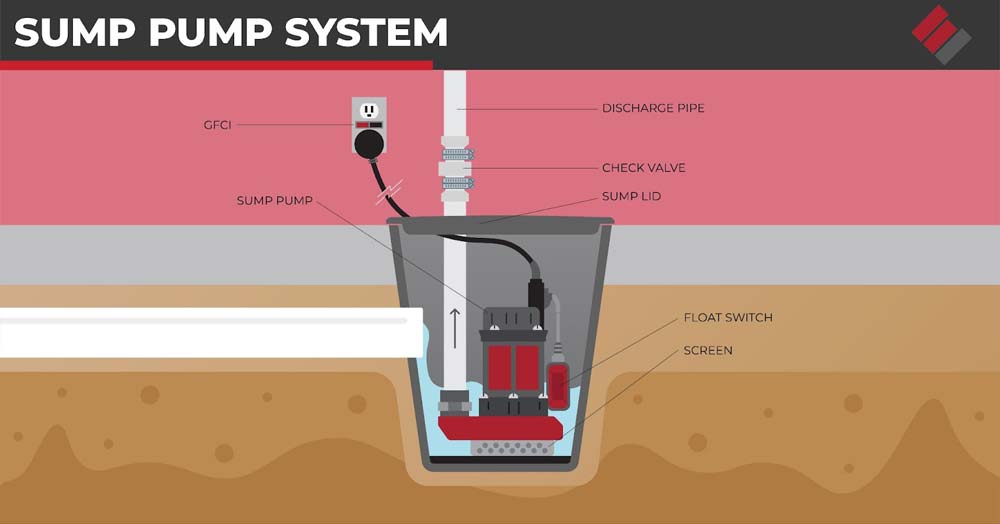
It’s essential to ensure that your sump pump is properly maintained to ensure that it continues to work efficiently. Regular maintenance should include checking the intake valve and discharge pipe for blockages, testing the automatic switch, and replacing worn or damaged parts. We strongly recommend a backup power source such as a battery backup or generator in case of power outages.
How Do Ejector Pumps Work?
Ejector pumps, also known as jet pumps, are hydraulic devices designed to move fluids, such as water, sewage, or slurries, from one location to another. They’re commonly used in residential, commercial, and industrial settings to pump wastewater, effluent, or other liquids from lower to higher elevations, where gravity drainage is not possible or feasible.
Ejector pumps operate on the principle of fluid dynamics, utilizing the Venturi effect to create suction and draw water or other fluids into the pump. The pump consists of a nozzle or jet assembly connected to a suction pipe or well point. The nozzle directs a high-speed jet of water or fluid at the throat of the venturi diffuser, where a constriction occurs, causing the velocity of the fluid to increase and the pressure to decrease.
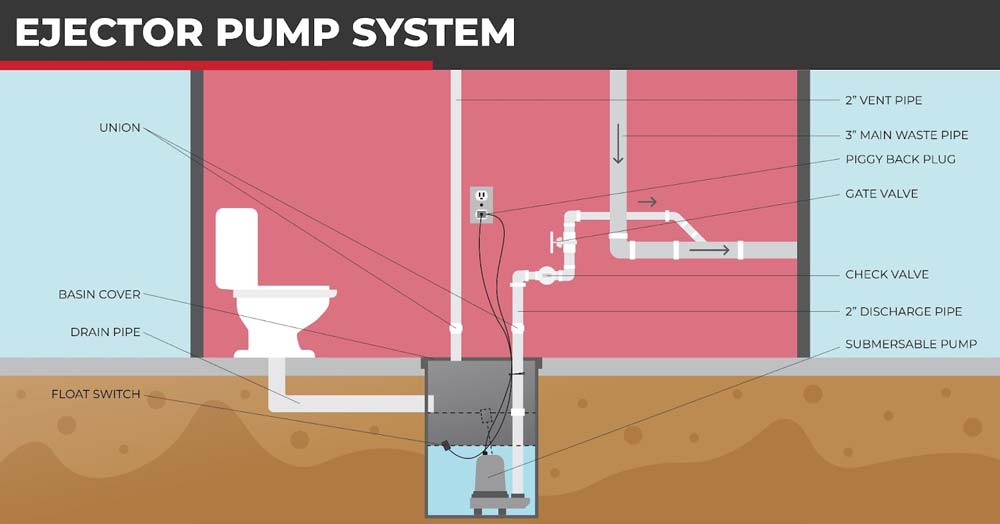
This pressure difference between the suction piping and the venturi diffuser creates a vacuum that draws the fluid from the source into the pump. The fluid is then mixed with the high-speed jet of water in the venturi, which imparts kinetic energy to the mixture, increasing its velocity and pressure. The resulting high-velocity fluid stream is then discharged through the pump’s discharge outlet or pipe, creating a hydraulic lift or force that moves the fluid to its desired destination.
Ejector pumps are versatile and durable and can handle a wide range of applications, including sewage transfer, groundwater dewatering, irrigation, and water supply. They’re often used in remote or rural areas where access to electricity is limited or unavailable, as they can be powered by gas engines, diesel engines, or manual pumps.
Ejector Pump Vs. A Sump Pump – Which Do I Need?
I’m trying to pump out sewage or wastewater
If you’re dealing with sewage or wastewater, an ejector pump is the way to go. An ejector pump is typically used when a bathroom or laundry room is located below the sewer line, making it difficult for waste to flow upwards and out of the home. In this case, an ejector pump is placed in a pit below the sewer line to lift the waste and pump it up to the level of the sewer line. Ejector pumps can handle solid waste and are usually larger and more powerful than sump pumps.
I’m trying to pump out water so my basement or crawl space doesn’t flood
On the other hand, a sump pump is generally used to remove excess water from a basement or crawl space to prevent flooding. A sump pump is placed in a pit (or a sump basin) and automatically turns on when water reaches a certain level. Sump pumps are not designed to handle solid waste and are typically smaller and less powerful than ejector pumps.
Can an Ejector Pump Be Used as a Sump Pump?
While there are some similarities between ejector pumps and sump pumps, namely that they are both used to remove water, there are also significant differences. As noted above, ejector pumps are designed to handle waste and sewage, while sump pumps are designed to handle clean water.
Moreover, ejector pumps have different design specifications and requirements, including the need for vents, whereas sump pumps have a simpler design with fewer requirements.
Therefore, while it may be possible to use an ejector pump as a sump pump, we don’t recommend it due to the differences in their design specifications and requirements. It’s always best to use the appropriate pump for its intended purpose to ensure optimal performance and avoid any potential damage or malfunctions.
Routine Maintenance for Ejector Pumps and Sump Pumps
To keep these pumps in top condition, regular maintenance is necessary. This includes removing debris or blockages from the pump, checking the pump’s motor and impeller for wear and tear, and testing the pump’s electrical connections to ensure they’re secure and functioning correctly.
It’s also essential to check the pump’s float switch to ensure it’s functioning correctly and that the pump is activating and deactivating at the appropriate water level. Regular testing of the backup power supply and alarm system is also necessary to ensure the pump will continue functioning during a power outage or other emergency.
If you’re concerned about keeping water out of your basement or crawl space, contact us today to schedule an evaluation. We serve areas in four states: Nebraska, Iowa, Kansas, and Missouri.

